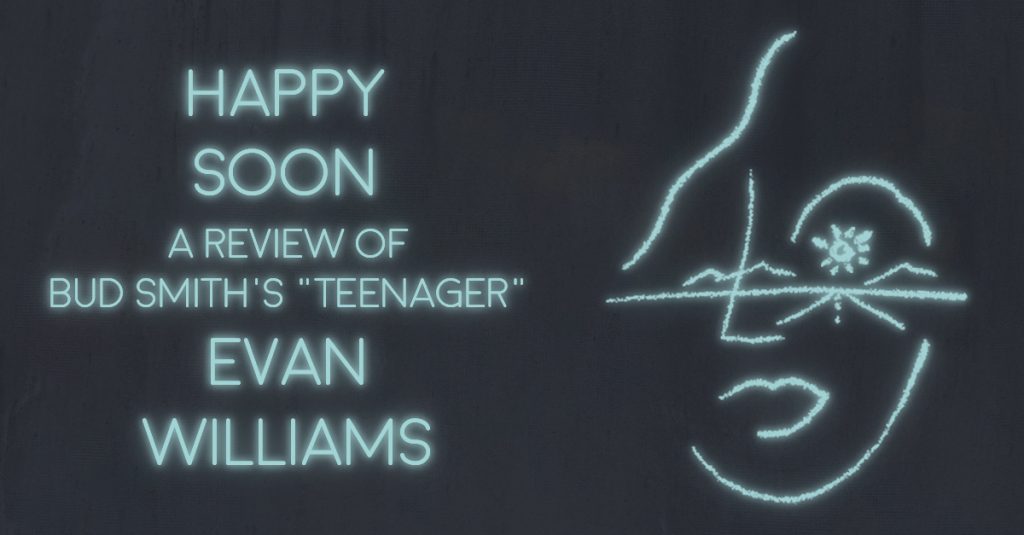Bud Smith’s Teenager is a story of almost. It’s a novel devoted to the idea of tip-of-the-tongue, a book deeply engaged with the entanglement between optimism and anxiety.
It is also a text which diagnoses the simultaneously short and far-sighted condition of youth, its absurd logic and its uncanny wisdom. Here’s what I mean: “Long as we are headed in the right direction…we’ll be happy soon.” It’s the soon in this line that cuts like a knife, it’s the soon that sits at the core of Teenager.
The question is, what does it mean to be ceaselessly engaged with the idea of soon? First and foremost, it implies that whatever comes with the arrival of soon is absent from the speaker’s now. To be happy soon is to acknowledge that one is not happy now. It means to be in constant search for the conclusion of soon. I realize that this all sounds terribly depressing. Don’t fear.
The pessimist’s reading of Teenager would insist that it is a book that never gets to be happy. The optimist’s reading would insist that it is a book slowly understanding what happiness is, slowly understanding what it is to have found it. I’m an optimist.
That happiness comes soon also implies a certain around-the-corner philosophy on life. Reading Teenager, I can’t help but think of motion as a form of happiness, or at least hopefulness. The book itself is defined by a constant motion, the main characters and lovebirds, Kody and Teal, dashing westward from New Jersey to in a dual attempt to flee law enforcement and to reach Kody’s personal paradise: a ranch in Montana. The book is simultaneously built upon motion away from and motion towards. The scientists among us will point out that, yes, this is in fact how motion works. I won’t argue, but I will say that hope is often depicted as simply a motion toward; for Smith, hope is a thing that must be pursued at high speeds, hope is a thing that is not caught, but that impels motion away from the less hopeful. It is tantalizing.
I should revise: Teenager is a book that portrays a coming into knowledge of the fact that hope is that which allows for motion, and motion is happiness. What Kody doesn’t understand at the book’s beginning, but does by the end is that the soon is the result of a faulty definition of happiness. As long as we’re headed in the right direction, we will be happy, period. It’s emphatic, a sort of smack in the face. It’s a mandate. What I love most about Teenager is its willingness to learn. To be clear, I don’t mean Smith’s willingness to write character arcs, or his ability to write a character who learns. No, I mean that I love the way that the book itself learns as it goes on, the way it comes to redefine happiness. Over the course of its 383 pages, Teenager understands happiness as motion away from hopelessness, then as simple motion, and then, finally, as a kind of stasis daring hopelessness to catch up.
This shines through in Teal’s imagined imprisoned life: “their children in the cells with them, inmates as well, conceived into it…they would crawl around on the concrete, be placed in the cells adjacent to mommy and daddy. Inmate children, growing, educated, falling in love with other inmates, starting prison families of their own…Teal, humming, happy, fulfilled, what more was life than loving your family?” In fact, Smith posits that hopelessness simply cannot catch up when love is present. In absolute stasis, love replaces the hopeful motion that defines happiness.
There’s a moment in Gertrude Stein’s 1935 essay, Portraits and Repetition, when she argues that in order to define an object, a person, a phenomenon and so forth, it’s necessary to set it against the motion of another object, person, or phenomenon; we define by the contrast that motion allows. What Stein would set out to do, of course, is define an object by drawing out its internal motion, the motion of the object’s essence. That project would become Tender Buttons, and the rest is history. I’m drawn to this concept because it seems to me that Smith has accomplished something similar. Not only has he succeeded in defining love by its own internal vibrations, its own internal rhythms, but he’s shown us the process leading up to that level of focus. Smith insists that love is a phenomenon that first defines itself by motion against our lives, our hopes and our fears, and that over time, as it deepens, love sheds its external phenomena layer by layer by precious layer until it exists in complete and timeless stasis.
PS: I can’t and I won’t discuss in detail the scene on pages 374-375 for reasons having to do with a proper and unspoiled experience of this fabulous novel, but I will say that they are perhaps the best two pages that I have read this year. More than any other passage in Teenager, 374-375 captures the kind of timeless love that Smith is after. They are masterful, and we are lucky to read them in our lifetime.

